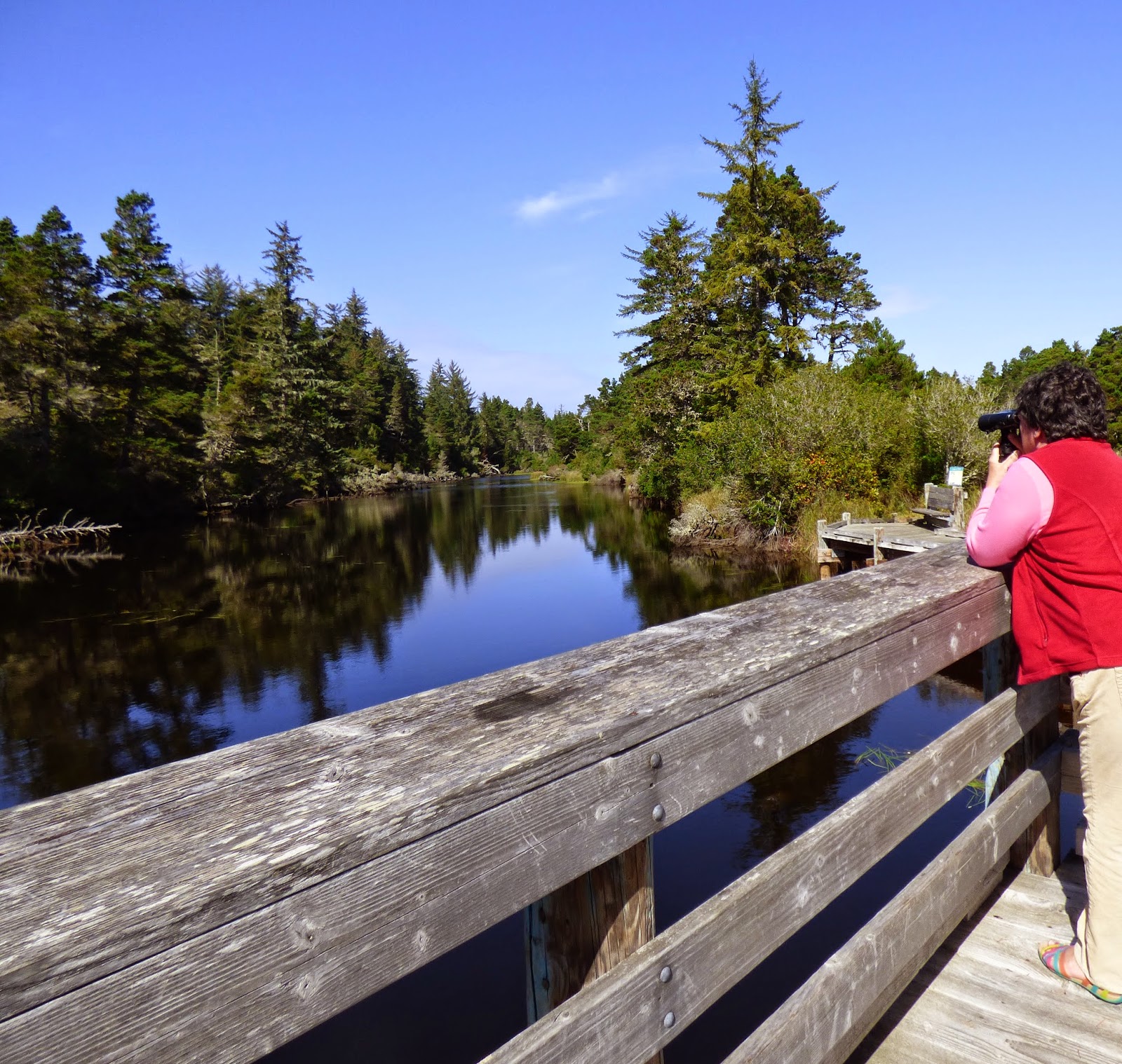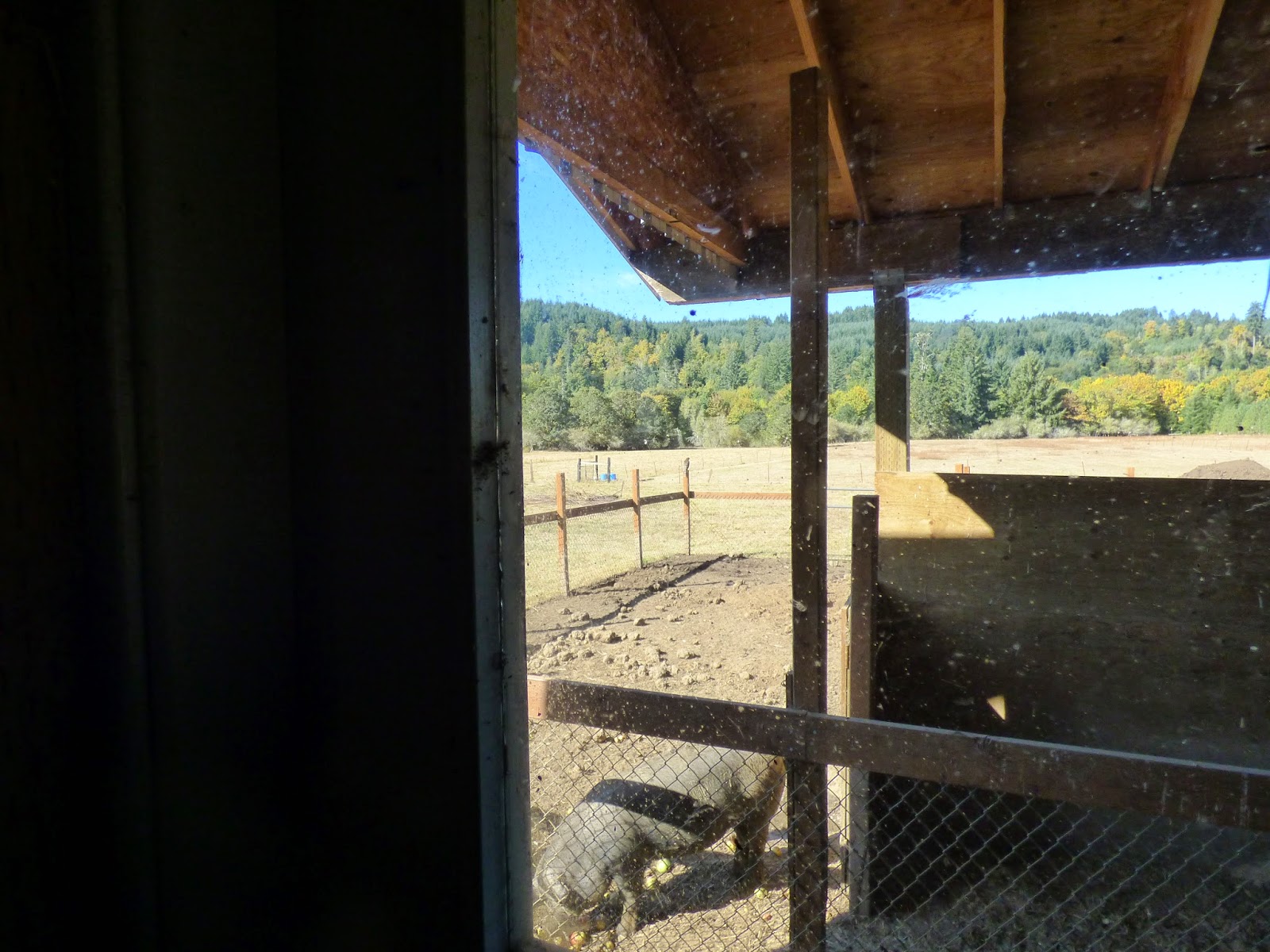I opted to not go on Friday's pelagic trip as I get seasick easily and there were small craft advisories. Reportedly, that was the best pelagic trip ever for number and variety of birds. But I probably would have seen few of them.
Friend Dawn and I drove down on Friday afternoon to arrive in time for registration, get-acquainted happy hour, and an absolutely delicious supper. Of course, we stopped here and there on our way to admire the view and birds.
 |
| Black Turnstones at Yachats Ocean Rd. |
 |
| Seal Rock area Pelicans and Cormorants |
 |
| Brown Pelicans, Western Gulls, and Cormorants atop the rock pictured above |
 |
| Dawn surveying the Siltcoos Lagoon (oxbow lake) |
 |
| What a quiet, beautiful and birdy spot |
 |
| Siltcoos River Lagoon Trail |
 |
| Hoodless Hooded Mergansers on the lagoon |
We arrived in Bandon in time to check into the hotel and head to the Community Center for registration, a wonderful supper courtesy of the OBA folks, and a fascinating talk/slideshow by Roy Lowe about the history of the coastal national wildlife refuges. Dawn and I plus friend Eugenia from Salem were staying at the Sunset Oceanfront Lodge. Even my economy room (or at least the deck a few steps from my door) had a spectacular view of the ocean and sea stacks. But we had little time to sit and admire the view either day.
 |
| The view from "my" deck |
The next morning, Dawn, Eugenia and I met the rest of our field trip crew and drove a very long way to Pistol River where we saw lots of birds that I did not get photos of, including Black Phoebe, Red-shouldered Hawk, Peregrine Falcon, one lone Dowitcher, plus lots of treetop birds like American Goldfinches, Pine Siskins, Bushtits, Yellow-rumped Warblers, Chickadees, etc. I only saw a fraction of the total birds seen. That held true for the next day's field trip as well. However, I missed none of the spectacular scenery.
I did a little better as we worked our way back north. Elegant Terns were flying and calling at the mouth of the river at Gold Beach. I managed to photograph them resting on buoys.
 | |
| Elegant Terns at Gold Beach |
At the Arizona State Recreation Area my sciatica gave me an excuse to sit on a picnic table and just look and listen for birds... plus catch up with an old friend, Tom Shreve. Part of the fun of this weekend was seeing old friends and meeting new ones.
 |
| Arizona State Recreation Area |
When the main group returned from their hike, Eugenia (my canoe companion at the Shorebird Festival of a few years ago) asked what we had seen, sitting on our picnic table overlooking the marshy pond. I told her we saw two Northern Waterthrushes, a juvenile Black-crowned Night Heron that we originally thought was a Bittern but then noticed two nearby Bitterns and realized our mistake... At that point Dawn, who had walked up with Eugenia, said, "You did not!" If Dawn had not called my bluff, I might have been able to add another twenty bogus birds. Eugenia trusts me not to lie. Or did.
Onward we went to Port Orford, where this curious Harbor Seal proved the easiest to photograph.
A couple of winter plumaged Pigeon Guillemots, looking nothing like breeding plumaged Guillemots, except for their red feet, were swimming and diving near the pier.
This Western Grebe was photographed somewhere, either at Port Orford or at a stop between there and our return to Bandon. Someday I'll remember to write down where I take photos. (Dawn says Port Orford dock. She types into her magic phone and pulls up this stuff.)
After another delicious meal and fabulous talk/slideshow by Dan Gleason, we collapsed into our beds.
Early the next morning, we met for a half day field trip to Bandon Marsh and other Bandon area locations. But the marsh was so productive, we spent most of our time there, much to my and my aching leg's relief. Tim Rodenkirk was again our enthusiastic and energetic trip leader, determined to mine every "good bird" in that marsh for everyone to see.
Wayne Weber from Canada came up with the first "good bird", a Red Knot. I never saw it and it soon left. Then Tim found a Pacific Golden Plover. I did see that one and tried to get photos but it was a long way off and hanging out with a flock of Black-bellied Plovers. The bird below may or may not be the "right" bird. Without seeing it next to the Black-bellies, it was impossible to see any difference. It was noticeably smaller when they were side by side.
Here is the crew looking out over the marsh. I mostly stayed up on the viewing platform, where I could lean on the railing to rest my leg... and see thousands of peeps a few miles away that the others could not see. Of course, I could not identify any at that distance.
I loved the colorful Marbled Godwits that worked their way close to us eventually.
My one claim to fame was alerting Tim to a flock of warblers (I had seen a Townsend's) and chickadees up by my viewing platform. Dawn scanned the flitting birds and saw what she thought was an Orange-crowned Warbler, except it had wing bars. Tim became very excited and said, "It has to be a Blackpoll Warbler! That's the only yellow warbler with wingbars that could be here now! There have only been two sightings in this county and neither were accepted!" (Yes, he really does talk with exclamation marks.) And so the search was on and Tim did, eventually, find it again, along with Ruby and Golden-crowned Kinglets, a Red-breasted Nuthatch, and more. I, of course, got photos of none of them. Co-leader Harv went back later that day and refound the warbler. He was going to go again with a camera to document their find. I wish him luck.
Between our morning and afternoon visits to the marsh, we went to the jetty and looked for turnstones, which we found but were very hard to see against the pilings.
We did see a Red-breasted Merganser there but my photos are even more pitiful than the rest of these photos. A Double-crested Cormorant cooperated, however.
We peeled off from the group after lunch and headed home. Naturally, we stopped at a few places, including the Umpqua River Lighthouse and the jetty below.
We had been told that Winchester Bay was a good place for terns and possibly jaegers, which were Dawn's quest, so we went there. Dawn spotted a BJ's Ice Cream sign from the highway so we wheeled in. The ice cream was wonderful. And the birding, too. We found our only Spotted Sandpiper of the trip and more terns and grebes that I did not get photos of. No jaegers, though.
Our next stop was an exploratory one at what was billed as a boardwalk and interpretive center on the Umpqua River at Reedsport. We thought the boardwalk went over a marsh but it did not. It bordered the river. (I guess that makes sense since it was called the Umpqua Riverfront Boardwalk.) An adjoining dock was occupied by a hunting Great Egret and a preening gull. Who would have thought?
It was time to keep moving so we made only one more stop, on our way home, at a lovely overlook, donated to the public by a generous man.
A bit after 5:30 p.m., I dropped Dawn off in Lincoln City and drove home, full of good memories of an amazing weekend. Next year's meeting will be in the Roseburg area, which doesn't hold as much thrill as the Oregon coast. But, if it's in September again, we'll see what speakers and field trips they come up with...





















































